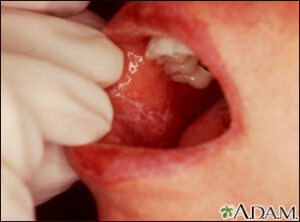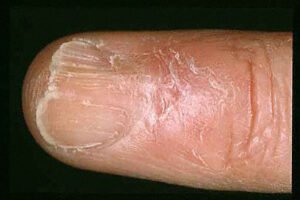Lichen Planus is a very common condition that I encounter on an almost daily basis in my The Woodlands dermatology and Conroe dermatology offices. There are many different clinical manifestations of Lichen Planus but the classic clinical picture are small pink/red/purple papules in a polygonal shape that have a small white lacy scale on the surface that is called Wickham’s Striae. Lichen Planus lesions are intensely itchy and when scratched they appear to spread due to an entity called Koebner’s Phenomenon, which is also seen in psoriasis. Lichen Planus can occur almost anywhere on the body and is commonly seen on the flexor surfaces of the wrists, legs, trunk, penis and in the oral mucosa. In most patients, Lichen Planus spontaneously resolves within 2 years but it can run a chronic course. Oral Lichen Planus is most common in women and can be of three different types: Reticulate (lacy white pattern), Ulcerative, and Erythematous. Unfortunately, the Ulcerative form of Lichen Planus is the most common form of Oral Lichen Planus, which can ultimately lead to the development of Squamous Cell Cancer in the ulcers. The buccal mucosa is the most common site of Oral Lichen Planus and the gingiva is the second most commonly involved area. It is extremely important to maintain meticulous oral hygiene in Oral Lichen Planus to mitigate exacerbations. In some patients, dental amalgams are responsible for Oral Lichen Planus and removing the inciting amalgam can result in resolution of the disease. Nail involvement is also very common in Lichen Planus and occurs in up to 10% of patients but is most common in children. Ridging and nail splitting are the most common nail manifestations of Lichen Planus but a phenomenon called 20 Nail Dystrophy may result in which every nail is completely distorted and dystrophic. Occasionally, the nails develop a Pterygium in which scarring and fibrosis obliterates the nail matrix and the proximal nail fold fuses with the proximal nail bed. Lichen Planus can be triggered by many factors including Hepatitis C virus, medicines (Hydrochlorothiazide, Antimalarials, NSAIDS, Gold, Captopril, and Penicillamine), but can be idiopathic. The 6 main types of Lichen Planus include: Classic Lichen Planus, Linear Lichen Planus, Annular Lichen Planus, Hypertrophic Lichen Planus, and Ulcerative Lichen Planus.

February 20, 2011




